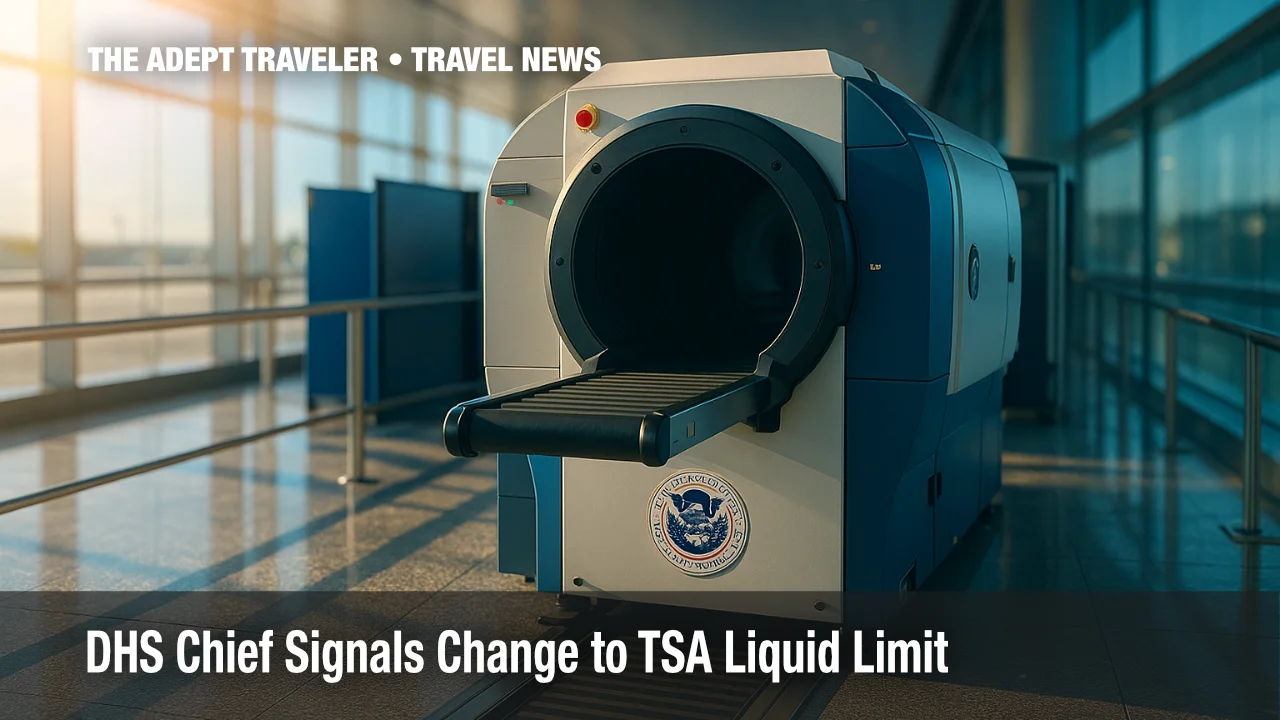DHS Chief Signals Change to TSA Liquid Limit

Travelers frustrated by stuffing toiletries into tiny bottles may soon catch a break. Homeland Security Secretary Kristi Noem said on July 16 that she is "questioning" the Transportation Security Administration's 3-1-1 liquid rule and suggested it could be the next major policy to change. The remark, delivered at the Hill Nation Summit in Washington, comes eight days after TSA scrapped its two-decade-old shoe-removal requirement. Any revision would lean on new 3-D scanners that detect explosives without forcing travelers to unpack liquids, potentially reducing checkpoint times to about one minute. No timeline was announced, and the current rule remains in force.
Key Points
- Why it matters: Millions could carry full-size toiletries, speeding lines and cutting waste.
- Noem called the 3-1-1 rule "the next big announcement."
- Advanced CT scanners enable larger liquid allowances without sacrificing safety.
- The shoe-removal rule ended nationwide on July 8.
- Travelers must still follow the 3.4-ounce limit until DHS issues formal guidance.
Snapshot
The 3-1-1 rule, adopted in September 2006 after a foiled U.K. liquid-explosives plot, caps each carry-on container at 3.4 ounces and requires all liquids to fit in one quart-size bag. Secretary Noem said DHS is reevaluating "everything TSA does," and liquids sit high on her list. Modern CT scanners create detailed, rotatable images that spot threats inside a closed bag, allowing officers to clear larger containers without manual checks. TSA has deployed the machines at 260 domestic lanes and aims for nationwide coverage over the next several years.
Background
Airport security tightened sharply after 9/11, then again in 2006 when authorities uncovered plans to detonate peroxide-based liquids aboard transatlantic flights. The United States adopted the 3-1-1 standard within days, aligning with allies and setting a global norm. Although effective, the limit has drawn criticism for spill-risk, plastic waste, and heightened screening times. Europe and the United Kingdom have begun lifting similar caps where CT technology is installed. U.S. officials had resisted change until DHS, under Secretary Noem, launched a wider modernization drive that already ended mandatory shoe removal.
Latest Developments
What Noem Said
Speaking on July 16, Noem told moderators she is "questioning the liquids [rule]" and hinted that an announcement on container size could follow the shoe policy rollback. She envisions a checkpoint where travelers "walk in the door, pass through a scanner, and head straight to the plane in about one minute."
Technology Driving the Shift
TSA's new CAT-2 CT scanners produce 360-degree X-ray slices, automatically detect explosives, and isolate suspect areas for officer review. The agency ordered 400 additional units in May 2025, focusing first on the largest hubs. According to TSA engineering briefings, a fully equipped lane can screen 720 passengers per hour-about 30 percent faster than legacy systems.
How Soon Could Rules Relax?
Noem gave no timetable and stressed that safety remains paramount. DHS must certify that scanners are installed widely enough and that software reliably flags disguised liquids before altering national policy. Industry officials predict a phased approach: an initial increase to roughly 17 ounces (500 milliliters) at CT-equipped checkpoints, followed by full removal of size limits as machines reach all 430 U.S. commercial airports.
Analysis
For travelers, a larger liquid allowance would simplify packing, cut costs on disposable minis, and shorten queues caused by bag pulls for oversized toiletries. Families with small children could carry ready-to-feed formula without special screening. However, uneven deployment means rules may vary by airport-requiring vigilance during the transition. International flyers must also respect each country's standards on the itinerary's tightest segment. Advisors should coach clients to check airport advisories 72 hours before departure and keep liquids easily accessible until the rule officially changes. Memberships such as TSA PreCheck will continue to offer the smoothest experience, especially while policies diverge.
Final Thoughts
DHS has already proven willing to retire outdated measures. If CT rollout stays on schedule, the 3-1-1 rule's days appear numbered. Until a formal bulletin drops, pack only 3.4-ounce bottles, keep receipts for medical liquids, and monitor DHS press releases. The next big leap toward friction-free screening may arrive sooner than expected-ending the era of tiny shampoo forever and rewriting the TSA liquid limit.
